
The American badger is a North American badger similar in appearance to the European badger, although not closely related. It is found in the western, central, and northeastern United States, northern Mexico, and south-central Canada to certain areas of southwestern British Columbia.
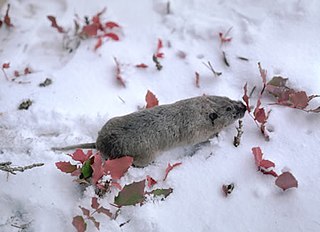
The northern pocket gopher is a small gopher species native to the western United States and the Canadian provinces of Alberta, Saskatchewan, British Columbia, and Manitoba.
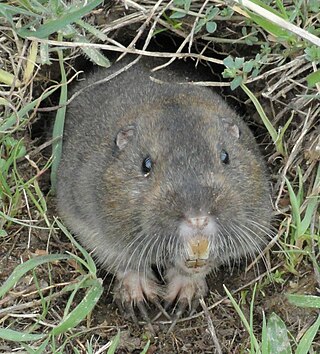
Pocket gophers, commonly referred to simply as gophers, are burrowing rodents of the family Geomyidae. The roughly 41 species are all endemic to North and Central America. They are commonly known for their extensive tunneling activities and their ability to destroy farms and gardens.

The smooth-toothed pocket gophers, genus Thomomys, are so called because they are among the only pocket gophers without grooves on their incisors. They are also called the western pocket gophers because they are distributed in western North America. They are considered distinct enough from other pocket gophers to be recognized as a separate subfamily or tribe.
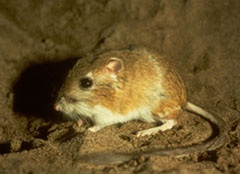
Ord's kangaroo rat is a kangaroo rat native to western North America, specifically the Great Plains and the Great Basin, with its range extending from extreme southern Canada to central Mexico.
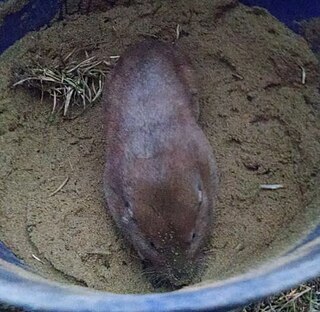
The southeastern pocket gopher is a species of pocket gopher that is native to the southeastern United States. It occurs in Alabama, Georgia, and Florida, where it is the only pocket gopher.

The California vole is a type of vole which lives throughout much of California and part of southwestern Oregon. It is also known as the "California meadow mouse", a misnomer as this species is a vole, not a mouse. It averages 172 mm (6.8 in) in length although this length varies greatly between subspecies.

Heermann's kangaroo rat is a species of rodent in the family Heteromyidae. Their long smooth pelage resembles typical kangaroo rats, with their dorsal side showing a mixed range of olive, black and orange colors. There are 9 distinguished sub-species of Dipodomys heermanni: D.h. arenae, D.h. berkeleyensis, D.h. dixoni, D.h. goldmani, D.h. heermanni, D.h. jolonensis, D.h.morroensis, D.h. swarthi, and D.h. tularensis. The dental formula of Dipodomys heermanni is 1.0.1.31.0.1.3 × 2 = 20.

The desert pocket gopher is a species of rodent in the family Geomyidae. It is found in the state of Chihuahua in Mexico and in Texas and New Mexico in the United States.
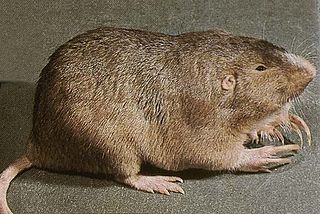
The plains pocket gopher is one of 35 species of pocket gophers, so named in reference to their externally located, fur-lined cheek pouches. They are burrowing animals, found in grasslands and agricultural land across the Great Plains of North America, from Manitoba to Texas. Pocket gophers are the most highly fossorial rodents found in North America.
Buller's pocket gopher is a species of gopher that is endemic to Mexico.

The Great Basin pocket mouse is a species of rodent in the family Heteromyidae. It is found in British Columbia in Canada and the western United States.

The Columbian ground squirrel is a species of rodent common in certain regions of Canada and the northwestern United States. It is the second largest member of the genus Urocitellus, which is part of the tribe Marmotini, along with marmots, chipmunks, prairie dogs, and other holarctic ground squirrels. They are stout, with short dense fur, which is characteristically tawny across the bridge of the nose. Social encounters sometimes are initiated with kissing behavior and the most common activity above ground is standing at attention. Residing in mountainous terrain and high plains in northern latitudes, they hibernate for 8 to 9 months of the year in burrows, which may be used for many years. They are emaciated when emerging in the spring. The Columbian ground squirrel came to the attention of the scientific community through writings produced by Lewis and Clark, while 21st century molecular genetics has more finely illuminated its ties with other close relatives.

The camas pocket gopher, also known as the camas rat or Willamette Valley gopher, is a rodent, the largest member in the genus Thomomys, of the family Geomyidae. First described in 1829, it is endemic to the Willamette Valley of northwestern Oregon in the United States. The herbivorous gopher forages for vegetable and plant matter, which it collects in large, fur-lined, external cheek pouches. Surplus food is hoarded in an extensive system of tunnels. The dull-brown-to-lead-gray coat changes color and texture over the year. The mammal's characteristically large, protuberant incisors are well adapted for use in tunnel construction, particularly in the hard clay soils of the Willamette Valley. The gophers make chattering sounds with their teeth; males and females make purring sounds when they are together, and the young make twittering sounds. Born toothless, blind and hairless, the young grow rapidly before being weaned at about six weeks of age.

The Wyoming pocket gopher is a species of gopher that is endemic to the United States. Between 1915 and 1979, it was generally considered to be a subspecies of the northern pocket gopher.

The Idaho pocket gopher is a species of rodent in the family Geomyidae. It is rather small, with a lightly built skull. Its fur color varies through the body and between individuals. Found in the western United States, it inhabits savannas, shrubland, and grasslands. Individuals live alone in burrows, staying active year-round. Many aspects of its behavior and biology are not well understood. The species is classified as being of least-concern by the International Union for the Conservation of Nature.

The mountain pocket gopher is a species of rodent in the family Geomyidae. It is endemic to California and Nevada. The Sierra Nevada are part of its range.

Townsend's pocket gopher is a species of pocket gopher endemic to the northwestern United States.

The southern pocket gopher is a species of rodent in the family Geomyidae. It is found in Mexico and the United States, usually in high altitude grassland and shrubland. It feeds on plant material and has an extensive burrow above which is a large heap of earth on the surface of the ground.
The Michoacan pocket gopher is a species of rodent in the family Geomyidae. It is monotypic within the genus Zygogeomys. It is endemic to Mexico where its natural habitat is temperate, high-altitude forests. Its numbers are declining and it is listed by the IUCN as "endangered".






















